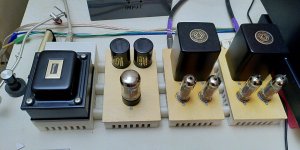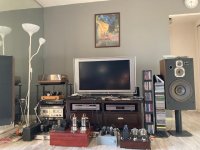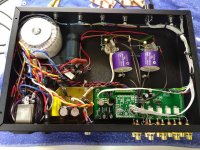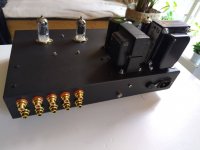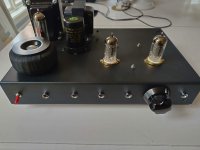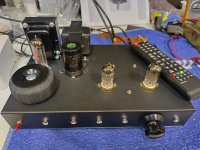My latest amps, 6L6 (or 807 with adapter) driven by a 12AT7.

Yes, the 6L6 is also in triode mode which gives me about 3W @ 1% THD.Looks great! A single ended amp?
40kg6/6bn11 all pentode mode single ended...no global negative feedback, local feedback around the output tube, the 40kg6 runs 80ma cathodes for now...all G2's are voltage regulated using Mosfet followers...
Attachments
-
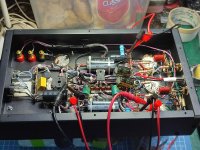 IMG_20221226_173013.jpg575.4 KB · Views: 277
IMG_20221226_173013.jpg575.4 KB · Views: 277 -
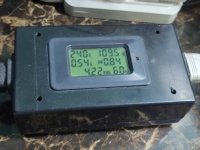 IMG_20221226_173005.jpg489.8 KB · Views: 264
IMG_20221226_173005.jpg489.8 KB · Views: 264 -
 IMG_20221226_094524.jpg423 KB · Views: 242
IMG_20221226_094524.jpg423 KB · Views: 242 -
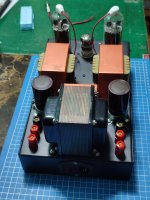 IMG_20221226_094520.jpg521.2 KB · Views: 235
IMG_20221226_094520.jpg521.2 KB · Views: 235 -
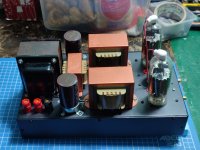 IMG_20221226_094505.jpg522.5 KB · Views: 260
IMG_20221226_094505.jpg522.5 KB · Views: 260 -
 IMG_20221226_094446.jpg576 KB · Views: 264
IMG_20221226_094446.jpg576 KB · Views: 264 -
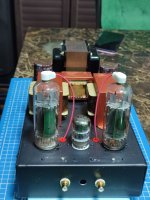 IMG_20221226_094444.jpg598.2 KB · Views: 285
IMG_20221226_094444.jpg598.2 KB · Views: 285
Great job! Beautiful amp you have built.Yes, the 6L6 is also in triode mode which gives me about 3W @ 1% THD.View attachment 1123601
My nifty little EL84 amp with 3d printed housing. I still need to finish the base plate but it sounds fine without it 😉 It serves as the mid-frequency amplifier in an active horn system. I guess a smartphone delivers more oomph than this baby, but that is not a problem.
Attachments
Nice and neat builidig. Have you got any schematic of it?
EL84 driving EL84 SE? Outside the Hammond box thinking, a clever way of separating the PS TX.EL84 amp
Thank you for your comment. No, it is push-pull, but without phase splitter to keep things simple, and twice the power in respect to a single ended stage. The line signal from the dsp feeding the amp is 1v max (configurable to 2v -but decided not to) so I needed the extra power. And I like push-pull due to lower distortion and more linear behavior. No NFB, no pre-amp. If more power is needed, you need a pre-amp that provides 8v, but in my home setting that is not relevant. The amp is very very quiet, that is important with a 110+dB sensitive driver.EL84 driving EL84 SE? Outside the Hammond box thinking, a clever way of separating the PS TX.
Last edited:
That was the second guess but preamps with the necessary full voltage swing aren't that common. Wasn't thinking 110 dB/w efficiency though. Triode mode? What primary impedance?
True that most pre-amps do not have such voltage swing. I do have a pre-amplifier from a legendary russian (St. Petersburg) tube equipment manufacturer that can put out a 30v swing, but that is exeptional.That was the second guess but preamps with the necessary full voltage swing aren't that common. Wasn't thinking 110 dB/w efficiency though. Triode mode? What primary impedance?
Ultralinear mode, 5kOhm primary for the output transformer (classic EL84, no surprise 🙂)The prototype of this amp with "Lafayette iron" is in use for the tweeter section of the horn, a.k.a. a tube flea-powered bi-amped BMS 4592ND compression driver to be precise. When funds permit, I'll build a proper one for the tweeters too, but the sound is already great.
If the attached 1/4 watt ~100 dB guess is close, also no surprise. In first year engineering school it was pounded into us that the soul of the practice is getting the absolute maximum result out of the absolute minimum engineering. Looks like you nailed out, congrats.classic EL84, no surprise...... the sound is already great.
Attachments
Thank you for the load line diagram, that is indeed correct. And total power available for both compression drivers -from 500Hz upwards- is about 1 watt, with the dsp digital volume control to 0dB attenuation, enough to annoy the neighbours 🙂If the attached 1/4 watt ~100 dB guess is close, also no surprise. In first year engineering school it was pounded into us that the soul of the practice is getting the absolute maximum result out of the absolute minimum engineering. Looks like you nailed out, congrats.
Yes, I believe in less is more, especially when music is involved, but you can also make things too simple. I think I hit the sweet spot, but it took a lot of time and personal development to get there. Money not so much, although the iron and other parts were not cheap. Per input channel, there is one coupling capacitor attached directly to the control grid of one EL84. The only other part in the signal path is the common cathode resistor. Incredibly simple and old schematic, but it simply works, even with "boutique" parts. I don't even know if you can speak of amplifiers in this respect, I would rather call them impedance matchers between the dsp and the horn driver. My philosophy is to let nature do the heavy lifting, as I view the horn as the amplifier, in an acoustic way. But that is outside the purpose of this thread. One of the reasons that you can directly inject the line level signal into the power tube without needing a driver tube is because the EL84 was designed to allow for that. With one or two volts of input, the output power is not great but for this goal it is o.k.
I2S mix down prototype. (Semi trolling). ADC + USB (via the MCU) mixed to DAC. Added the TFT screen to see how far I could push loading the main thread in between mixing audio packets. It seems quite a lot as the VU bars were originally updating so fast they were just a blur. I had to slow them down with delays to be visible.
Can you show us the schematics?Yes, the 6L6 is also in triode mode which gives me about 3W @ 1% THD.View attachment 1123601
Here are pictures of a pre-stage I'm putting together. I've had an old lab pre-amp I built on for many years and constantly rebuilt. Recently, I have found a construction I like and thought of putting it in a better chassis with good volume control and input selector.
The volume is a Muses 72323 (Meldanos version) which is very finely stepped and precise. Heard that Nelson Pass uses the same in their reference pre-amp. This unit is programmed with remote control.
The pre-stage itself is a White Catode follower with ECC802S tubes. Tube rectifier CLC-coupled and DC heaters. Also wanted to test one of the Black Gates I got a while ago.
Music is flowing and feeling well 🙂
The volume is a Muses 72323 (Meldanos version) which is very finely stepped and precise. Heard that Nelson Pass uses the same in their reference pre-amp. This unit is programmed with remote control.
The pre-stage itself is a White Catode follower with ECC802S tubes. Tube rectifier CLC-coupled and DC heaters. Also wanted to test one of the Black Gates I got a while ago.
Music is flowing and feeling well 🙂
Attachments
- Home
- Amplifiers
- Tubes / Valves
- Photo Gallery
